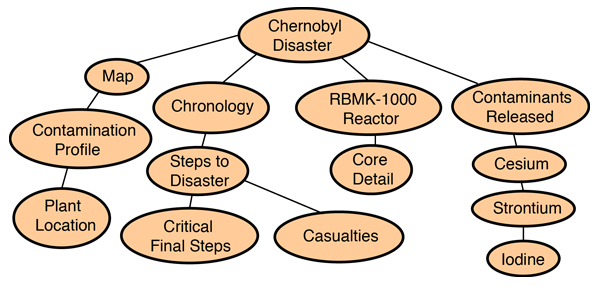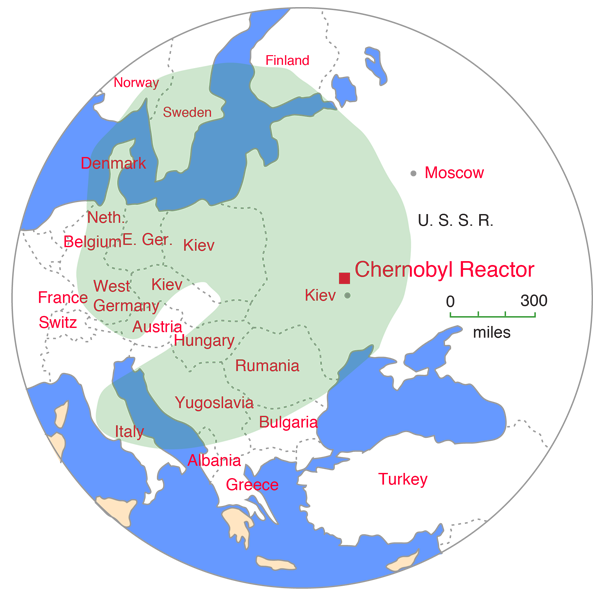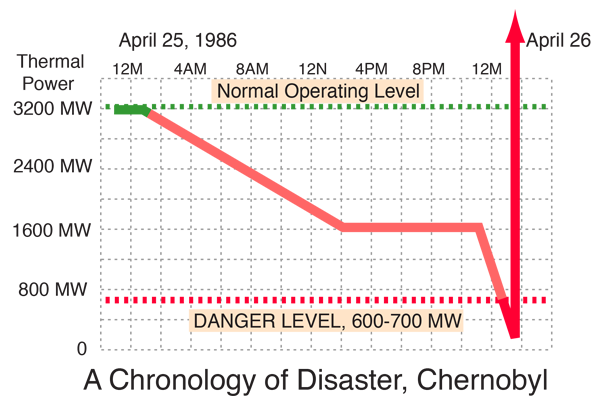Chernobyl
On April 26, 1986, a major explosion occurred at one of the four RBMK-1000 graphite-moderated power reactors at Chernobyl, 80 miles north of Kiev in USSR.

Nuclear energy concepts
Fission concepts
| HyperPhysics***** Nuclear | R Nave |
ChernobylOn April 26, 1986, a major explosion occurred at one of the four RBMK-1000 graphite-moderated power reactors at Chernobyl, 80 miles north of Kiev in USSR.  |
Index Nuclear energy concepts Fission concepts | ||
|
Go Back |
Chernobyl Radioactive Contamination Cloud This is a depiction of the contamination cloud roughly following that reported by Time Magazine on May 12, 1986. Some of the first reports of radioactivity came from Finland since the U.S.S.R. was silent about the accident until after it had been detected by its neighbors to the north. With time, some detectable radiation spread throughout the world. |
Index Chernobyl concepts Nuclear energy concepts Fission concepts | ||
|
Go Back |
Chernobyl
|
Index Chernobyl concepts Nuclear energy concepts Fission concepts | ||
|
Go Back |
Chronology of the Day of Disaster
|
Index Chernobyl concepts Nuclear energy concepts Fission concepts References Kress Edwards | ||
|
Go Back |
Chernobyl Chronology1. The reactor was powered down for a test sequence to determine if one of the turbogenerators could supply power to feedwater pumps until standby diesel generators came on line in the case of a local power failure. The test sequence involved the following dangerous steps a. Instead of the design based 22-32% full power, the power was inadvertantly lowered to 1% of full power, an extremely unstable situation because of the positive void coefficient. Edwards reports that the operator failed to reprogram the computer to maintain power at 700-1000 MW(t). b. Essentially all the control rods were pulled out of the core, to the point where they could not shut down the reactor rapidly if needed. This step was taken to get the power back up, but it only reached 7%, still well below the design parameters for the test. The reason the power could not be brought back up was the "xenon trapping" or "xenon poisoning" effect. Xenon is a decay product of I-135 and is a strong neutron absorber which "poisons" the fission reaction. It reaches an equilibrium at normal operating power levels by being "burned away" by neutron absorption and further decay. When the power level was decreased from the 1600 MW level, you had lots of I-135 to decay into xenon, but a small neutron flux with which to burn it away, so it built up rapidly. Excellent description of this by Kress on pg 45. Good one paragraph summary of accident on p46. c. In order to keep the reactor from automatically shutting down under these conditions, they had to disconnect the emergency core cooling system and several of the automatic scram circuits. d. All eight cooling water pumps were running at the low power, compared to a normal six even at full power, so there was nearly solid water with almost no void fraction, which increased the vulnerability to any power excursion which produced boiling. 2. The turbogenerator was tripped to initiate the test, which caused the switching off of four of the eight recirculation pumps. (This would have scrammed the reactor if the automatic scram circuit had not been disconnected.) 3. Reduced coolant flow caused voids to form rapidly in the pressure tubes, increasing reactivity because of the positive void coefficient. 4. Within seconds, with rapidly rising power, an emergency manual scram was ordered, but the almost fully withdrawn rods could not insert negative reactivity fast enough because of their slow speed. Also, an unexpected displacement of water from the control rod tubes occurred, further adding to the positive reactivity. 5. The core went to prompt criticality, overheating and shattering fuel rods and flashing the coolant into steam. Fuel channels were ruptured. 6. Steam pressure blew the 1000-ton steel- and cement-filled biologic shield off the top of the reactor, severing all pressure tubes(some 1600 of them) and exposing the hot core to the atmosphere. Edwards says power reached 100 times operating maximum and the explosive force was about 1 ton of TNT. Soviet scientist Legasov said of the violations of the safety restrictions "It was like airplane pilots experimenting with the engines in flight." The ORNL review says that if the operators had failed to complete the test they could not have repeated it for a year. This probably influenced them to take more risks than normal.
|
Index Chernobyl concepts Nuclear energy concepts Fission concepts References Kress Edwards | ||
|
Go Back |